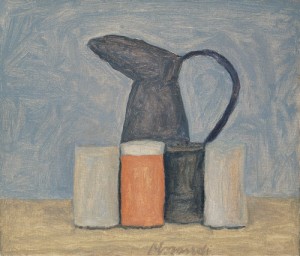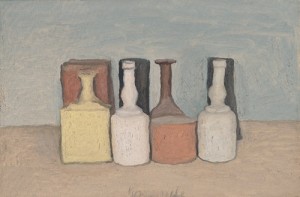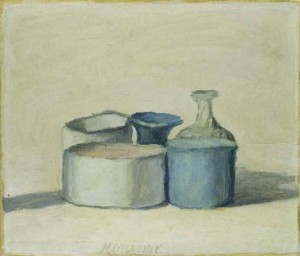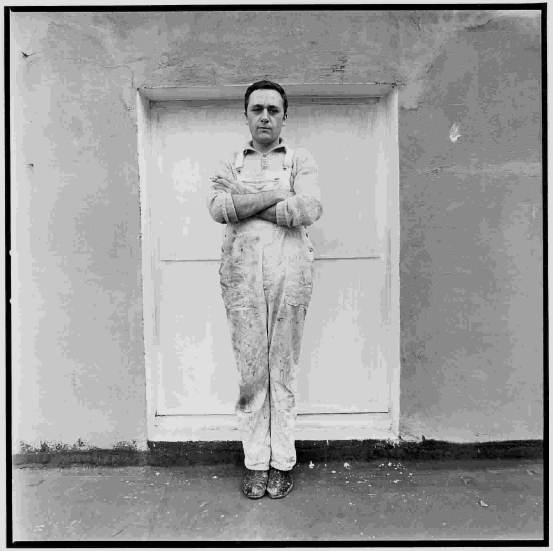Giorgio Morandi
When a writer gets described as writing the same story again and again, the tone’s usually accusatory, like it’s a bad thing to be noticed doing. But here is this guy, Giorgio Morandi, who painted the same objects arranged in still life again and again. He got really into these objects and seeing what he could do, how he could render what was really there, and what was really there–light–was always changing.
Interview with Brian Conn
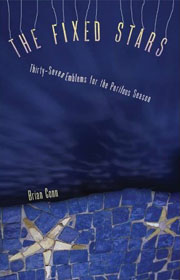 At Raintaxi, there’s an interview with Brian Conn, author of The Fixed Stars, a really wonderful novel—an anthropology of late capitalism, its language and myths. Conn answers Jedediah Berry’s questions about writing the book–structural choices, influences (including Cosmicomics, Marie Redonnet, Brothers Grimm), the interplay of language and math.
At Raintaxi, there’s an interview with Brian Conn, author of The Fixed Stars, a really wonderful novel—an anthropology of late capitalism, its language and myths. Conn answers Jedediah Berry’s questions about writing the book–structural choices, influences (including Cosmicomics, Marie Redonnet, Brothers Grimm), the interplay of language and math.
Conn wrote about half the book during a summer alone in Hawaii. Of that time he says,
After I finished a section I would wander around for several days trying to think of some event or voice or revelation that would, in some poorly comprehended yet very particular way, contradict everything that I’d already written. I’d discard idea after idea, and then at some point I’d think of an idea and laugh out loud, suddenly and involuntarily, and this idea would be the basis of the next section.
I now think of that summer as a time of intoxicating creativity, and simultaneously of terrifying confusion and despair. I’m sure these two impressions are closely related. I can see the causality flowing in either direction: maybe creativity is actually deeply terrifying, maybe confusion and despair forced me to abandon my usual thinking and reach for something new. Maybe both.
That we
have no ears to hear the
music the spores shot off
from basidia make obliges us
to busy ourselves microphonically.
-John Cage in Indeterminacy, a lecture performance in which Cage recited a series of one-minute stories and anecdotes in no particular order. Cage was a mycologist and many of the stories were about mushrooms. Some of the mushroom stories are collected here.
“On the Youth at Night”
The youth at night would have himself driven around the scream. It lay in the middle of the city gazing back at him with its heat and rosepools of flesh. Terrific lava shone on his soul. He would ride and stare.
-Anne Carson, “On the Youth at Night,” in her book Plainwater
“I FEEL THAT THE BEAUTY OF FORMS OBSCURES THE NULLITY THEY CHOREOGRAPH OR ENCHANT. I FEEL THAT THE NULLITY IS NOT THE SPACE AGAINST WHICH THE BEAUTY OF FORMS IS A FACT BUT THAT THE BEAUTY OF FORMS IS THE NULLITY ITSELF, TRANSMOGRIFIED, AND I FEAR THIS.”
Life of a Star by Jane Unrue
This was our playroom now, shared bedroom too. Those walls that had been mine were ours now, papered in a faded floral, seams and corners peeling, bubbled in some places, cracked. On every wall a stitchery picture: scenes from storyland were also faded. Soiled. No glass. Frames: chipped-off painted wood. Threads pulled in places, evidence of little fingers that can’t keep from touching, pulling—as if doing so could take a body out of this and into that: round wooden door to mouse’s tree-trunk house; white wicket gate set in the background of a garden overgrown with purple blooms; enchanted cottage all but hidden in a forest thicket; green-and-ruby turret window that, despite the ravages of time and all those dirty little fingers, still appeared to be enough to make a castle glow. And in that decorated room that had been mine but now belonged to us, the place in which unpleasantness seemed not just possible but downright inescapable, I told her stories with more stories stacked on top, all set in carefully described locations peopled with the characters I represented and the objects I pretended (on behalf of characters) to see, pick up, and operate.
(Read more of this excerpt from Jane Unrue’s recently released novella, Life of a Star, on Ben Marcus’s blog. The book can be purchased from the publisher, Burning Deck.)
To celebrate the release of Harold Abramowitz’s book, Not Blessed, Les Figues is having a contest that involves remixing selections from the book. The deadline is April 30. Guidelines are on the Les Figues site. I read Not Blessed recently and it’s good. It works by what feels like a literary equivalent of persistence of vision.
Tree for Friday
It’s Friday. Have a wonderful description of trees.
When I’m surrounded by trees, a condition I’ve sought out pretty persistently throughout my life I think the thing I might like the most about them is this whisper like all the hair of the world passing through the tunnel of one single breath – if that is a form of percussion. This irregular hiss of trees and wind. I think it is my mother. And I am her son, and you are my dog.
from “Protect Me You” by Eileen Myles.
Power Quote: Gerhard Richter
“I don’t want to be a personality or to have an ideology. I see no sense in doing anything different. I never do see any sense. I think that one always does what is being done anyway (even when making something new), and that one is always making something new. To have an ideology means having laws and guidelines; it means killing those who have different laws and guidelines. What is the good of that?”
from The Daily Practice of Painting by Gerhard Richter
Thought Experiments
If you had to go to a party dressed as the last animal you killed, what would you go as? I’d probably go as a newt, or if that newt didn’t die, then I’d be a fruit fly. Schrödinger either would or wouldn’t be a cat, depending on something random.
At least one person has said that much of modern physics is built on thought experiments. Einstein’s thought experiment about chasing a light beam got him to his theory of relativity.
Do you use thought experiments, or something like them, in your writing? Or, another way: how do you make environments using language?
P.S. It isn’t new, but check out “Keats in Space” by Molly Young for a discussion of the fusion of poetry and science. Also, Natalie’s poem “Water Experiment” and the discussion that follows gives you some poetry and science.

